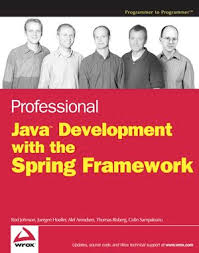Professional Java Development with the Spring Framework: A Comprehensive White Paper
1. Introduction
The Spring Framework has emerged as a dominant force in the Java ecosystem, providing a robust and flexible foundation for building enterprise-grade applications. This white paper aims to provide a comprehensive overview of the Spring Framework, exploring its key features, benefits, and best practices for professional Java development.
2. Core Concepts of Spring Framework
- Dependency Injection (DI):
- Spring's core principle, enabling loose coupling between components.
- Components declare their dependencies, and the Spring container injects the required objects.
- Promotes modularity, testability, and maintainability.
- Aspect-Oriented Programming (AOP):
- Enables modularization of cross-cutting concerns (e.g., logging, security, transaction management).
- Aspects define reusable modules that can be applied to other components without modifying their code.
- Data Access Objects (DAO):
- Provides an abstraction layer for database interactions.
- Simplifies database operations and improves code reusability.
- Transaction Management:
- Supports declarative and programmatic transaction management.
- Ensures data consistency and integrity in database operations.
- Testing Support:
- Provides robust testing frameworks and utilities for unit testing, integration testing, and more.
3. Key Modules of Spring Framework
- Spring Core:
- Foundation of the framework, providing dependency injection and core utilities.
- Spring Data:
- Simplifies data access with support for various data stores (e.g., relational databases, NoSQL).
- Spring Security:
- Provides comprehensive security features, including authentication, authorization, and data encryption.
- Spring Web MVC:
- Enables the development of web applications using the Model-View-Controller (MVC) architectural pattern.
- Spring Boot:
- Simplifies application development and deployment by providing an opinionated approach and auto-configuration.
4. Benefits of Using Spring Framework
- Increased Productivity:
- Reduces development time and effort by providing pre-built components and a streamlined development process.
- Improved Code Quality:
- Encourages loose coupling, modularity, and testability, leading to more maintainable and robust applications.
- Enhanced Testability:
- Facilitates unit testing and integration testing through dependency injection and other features.
- Strong Community and Ecosystem:
- Large and active community, extensive documentation, and a wide range of available libraries and tools.
- Flexibility and Extensibility:
- Highly customizable and can be easily integrated with other frameworks and technologies.
5. Best Practices for Spring Development
- Follow Dependency Injection Principles:
- Design components with clear dependencies and inject them through the Spring container.
- Utilize Aspect-Oriented Programming Effectively:
- Identify and modularize cross-cutting concerns using aspects.
- Write Unit Tests:
- Thoroughly test all components using Spring's testing framework.
- Follow Coding Standards:
- Adhere to consistent coding conventions and best practices for maintainability.
- Leverage Spring Boot for Rapid Development:
- Utilize Spring Boot's auto-configuration and opinionated approach to accelerate development.
6. Real-World Use Cases
- Enterprise Applications:
- Widely used in building complex enterprise applications, including e-commerce platforms, banking systems, and CRM systems.
- Microservices:
- A popular choice for building microservices architectures, enabling the development of independent and scalable services.
- Cloud-Native Applications:
- Well-suited for cloud-native development, with support for cloud platforms like AWS, Azure, and Google Cloud.
7. Conclusion
The Spring Framework is a powerful and versatile tool for Java developers, offering a comprehensive set of features and a robust ecosystem. By following best practices and leveraging its key capabilities, developers can build high-quality, scalable, and maintainable applications with increased productivity and efficiency.
References
- Spring Framework Documentation:
- Spring in Action (Book): Craig Walls
- Effective Spring (Book): Rod Johnson, Juergen Hoeller
Note: This is a high-level overview. For a more in-depth understanding, refer to the official Spring documentation and recommended books.
This white paper provides a foundational understanding of the Spring Framework. It can be further expanded by including specific examples, advanced topics like Spring Security and Spring Data, and a discussion on the future of the Spring ecosystem.



